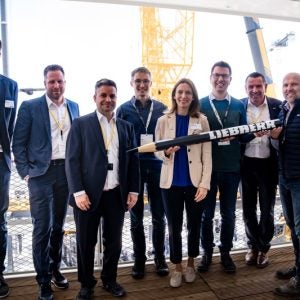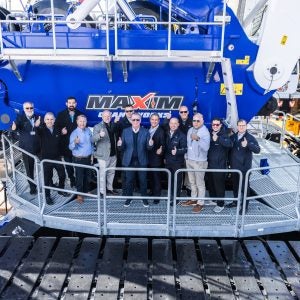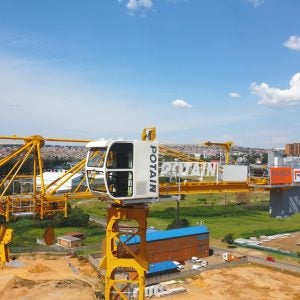At the launch, Terex-Demag chairman Alexander Knecht and Terex Cranes president Steve Filipov handed over the keys to the new crane to Alex Mullins of Al Jaber. Filipov thanked Al Jaber for their investment in the new twin boom crawler crane, valuing it at EUR20m ($28.27m).
At a presentation before the unveiling of the new crane, on Tuesday 2 October, Terex Cranes president Steve Fillipov explained that he had struggled to find anything to which the Twin could be compared. The best comparison, he suggested, was a bottle of fine wine, refined over years of maturing.
At the same presentation, Al Jaber Heavy Lift general manager Alex Mullins described the long process of development of the crane, from an initial request to a final design. The original idea had come from Al Jaber, back in 1999, when the Abu Dhabi-based firm had asked for a 2,000t crane. The only manufacturer to respond positively to this request, Mullins said, was Demag, at that time still independent of Terex.
The German manufacturer’s first suggestion was a CC5800, mounted on a ringer system. This, however, didn’t fit Al Jaber’s needs: instead, they wanted a modular system, similar to a conventional crawler. At the same time, as the development process continued, so the requirements of Al Jaber’s customers increased. Al Jaber went back to Demag, this time asking for a 3,000t capacity crane. A new design suggestion again required a ringer system, but, Mullins said, this would have meant that too much of Al Jaber’s investment stood idle on smaller jobs.
Terex-Demag’s final design for the Twin, developed over the last two years, has met all of Al Jaber’s requests. Instead of a ringer, the top section of the crane receives additional support from an integrated circular track with rollers on the crawler base, around the slewing ring. This means the two CC8800-1 top sections can be carried on an extended, but otherwise standard, crawler base, allowing the crane to pick and carry even on congested sites.
The modular system uses standard CC8800-1 parts, with only a limited number of specialised parts needed in the Twin kit. In the crawler base, an extension section increases the carrier width to 14m. On top of the base, as well as the circular track, a bridge adapter allows two boom sections to be mounted: the adapter is supported at either end by the track, and in the middle by the slewing ring. Above the adapter, twin CC8800-1 boom sections are connected by cross-bracings.
Behind the crawler base, the counterweight carrier and two Superlift trays of the CC8800-1 are combined by means of a connection unit into a patented counterweight system, of 1740t. Working at full capacity, the crane, its load, and counterweight, can come to a combined weight of over 6,000t.
A specially designed hydraulic system in the counterweight carrier, combined with an advanced electronic system, makes the precise changes needed to keep this huge crane perfectly balanced. On the front of the crane, in the SSL69 configuration shown at the launch 4 x 22 falls of rope (or 2 x 22 on each side) lift another special adapter, connecting the two booms to a modular spreader and twin hook blocks.
At the launch, the first crane was equipped with a 69m main boom. This can go up to 117m, with a luffing jib of the same length available, for a maximum hook height of 235m. A special Vessellift system is available for use in petrochemical plants, allowing the crane to erect 100m high columns weighing up to 1,800t.
Terex’s dual boom CC8800-1 Twin, capable of lifting 3,200t Terex CC8800-1 Twin The lifting point of the CC8800-1 Twin. A single 800kg pin connects this adapter to a modular spreader bar. Twin lifting gear Alexander Knecht hands the keys to the CC8800-1 Twin to Al Jaber’s Alex Mullins, as Steve Filipov (right) and Saarland’s minister for economic affairs (left) look on. Knecht, Filipov, Mullins, minister






